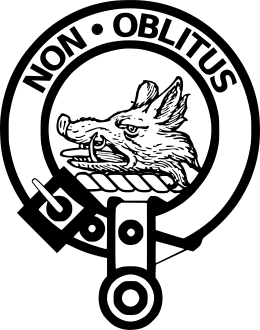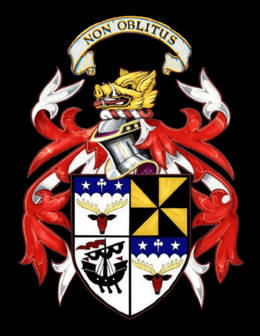Clan MacTavish facts for kids
Quick facts for kids Clan MacTavish |
|||
|---|---|---|---|
| MacTamhais, MacTavish, McTavish, Mactavish, MacTavis, M‘Tavish, Thomas, Thomson, Thompson | |||

Crest: boar’s head erased or langued gules within a plain circlet bearing the motto "NON OBLITUS"
|
|||
| Motto | NON OBLITUS. | ||
| War cry | CRUACH MOR | ||
| Profile | |||
| Region | Highland | ||
| District | Argyll | ||
| Pipe music | "MacTavish Is Here" | ||
| Chief | |||
 |
|||
| Steven Edward Dugald MacTavish of Dunardry | |||
| Chief of the Name and Arms and Chief of the Clan MacTavish, the 27th Hereditary Chief from an unbroken line (Mac Tamhais Mor) | |||
| Historic seat | Castle of Dunardry | ||
|
|||
Clan MacTavish is an old and respected Scottish clan from the Scottish Highlands. For a long time, the clan's leaders were known as "MacTavish of Dunardry." The MacTavish chiefs are proud of their history and do not consider themselves part of Clan Campbell. They believe their family comes from an ancient Irish background.
Clan History: Where Did We Come From?
Early Beginnings
The MacTavish clan might have come to Scotland from Ireland a very long time ago. Some old Irish records from the 15th or 16th century, like the Cert Ui Neill, mention the MacTavish name. These records suggest that MacTavishes held land in a place called Ros Buill in what is now County Donegal, Ireland.
Another old Irish poem from around 1372 also talks about the MacTavishes. It says that "MacGillatsamhais" (an old form of MacTavish) ruled Ros-Guill and Ros-Irguill. These areas were once led by "Boar Kings." It's interesting because the MacTavish clan's special symbol, called a crest badge, is a boar's head! This might connect the clan to these ancient "Boar Kings."
Some people, especially those from Clan Campbell, used to think that the MacTavishes came from a person named Tàmhas (also called Tavis Coir). He was believed to be the son of Colin Mael Maith. However, many MacTavishes and historians believe the clan's ancestor was a real person named Sir Thomas Cambel. He was recorded as a landowner in Scotland in 1292. In 1355, his possible son, Duncan, was called "Duncanus MacThamais." This shows the name "MacTavish" was used early on.
It's important to know that the MacTavish chiefs have always said they are not related to the Campbells. They believe they are from an older, separate Scottish-Irish background. In fact, a Scottish book from 1957 said that Clan MacTavish is one of the original Scottish clans. A clan is a distinct group, not just a smaller part (called a sept) of another clan.
Old writings from 1793 suggest that MacTavishes lived at Dunardry around 893 AD. This is much earlier than when the Campbells arrived in Argyll, which was around 1220. This makes it difficult to say that MacTavishes came from the Campbells.
Even though they were distinct, the MacTavishes often supported the Campbell chiefs in their goals. The 10th Duke of Argyll noted that while MacTavishes were not a huge clan, they were known as brave and honorable. They often followed the Campbell leaders in battles.
The main line of MacTavish chiefs is known as "MacTavish of Dunardry." The name Dunardry means "fort of the High King." No one knows exactly when Dunardry Castle was built, but it was shown on a map from 1634. It was later torn down to make way for the Crinan Canal.
The Battle of Flodden (1513)
The Battle of Flodden was a very bloody fight between Scotland and England. It was one of the most costly battles for Scotland in terms of lives lost. Many Scottish noble families suffered losses. In this battle, Duncan, who was the 6th Chief of MacTavish, died. His son, Ean (the 7th Chief), and Duncan's brother, Allan, also died, along with other MacTavish and Campbell clan members.
The 17th Century and Civil War
In 1685, during a rebellion against King James VII, Carnasserie Castle was attacked and partly destroyed. A young MacTavish, Dugald MacTavish, was sadly killed during this time.
Later, in 1648, another Dougal MacTavish, a younger son of the 12th chief, was killed during the Battle of Stirling (1648).
The 18th Century and Jacobite Uprisings
In 1715, there was a movement called the Jacobite cause. Its goal was to put the Stuart family back on the Scottish and English thrones. Chief Archibald MacTavish was sympathetic to this cause, but he didn't actively join the fight.
In 1745, during another Jacobite uprising, Chief Archibald and his son, Dugald MacTavish the Younger, were put in Dumbarton Castle. Because they were imprisoned, the MacTavish clan didn't have a formal leader in the Jacobite army. Some MacTavishes ended up fighting with other clans, like the MacIntosh clan. The MacTavishes were imprisoned because of letters that suggested they planned to support Prince Charles and the Jacobite cause.
On April 16, 1746, the Jacobite army was defeated at the Battle of Culloden by a larger British government force. This battle ended the Jacobite cause.
After Culloden
The defeat at Culloden in 1746 greatly changed the lives of Highlanders and their chiefs. The government wanted to break the power of the Highland clans and change their traditional way of life. Chiefs lost their power to raise armies, and the government took control of lands from those who had joined the rebellion. Highlanders were even forbidden from wearing tartan (like the kilt) or carrying weapons.
However, the MacTavish lands were not taken by the government. This was because both the MacTavish Chief and his son had been in prison during the rebellion. Dugald MacTavish was released and pardoned in 1747. After his father Archibald died, Dugald became the chief.
Highland Clearances
It's important to note that the MacTavish chiefs did not force their tenants or clan members to leave their lands during the Highland Clearances. This was a time when many Scottish landowners made their tenants move off the land, often for sheep farming.
After Culloden, some MacTavishes started using the spelling Thom(p)son for their name. However, the main line of MacTavish chiefs kept the name MacTavish and stayed at Dunardry.
Selling Dunardry Estate
Lachlan MacTavish became chief in 1775. In 1785, he had financial problems, so the Dunardry estate was put up for sale. It was bought by Campbell of Barbeck. Lachlan, his wife, and young son Dugald moved to Edinburgh.
Later, in 1797, Simon McTavish of Montreal bought Dunardry. He was a very rich fur trader from Canada. The estate eventually returned to Lachlan's son, Dugald MacTavish, who then sold it to Malcolm of Poltallach.
The 20th Century and Revival
For a long time, the MacTavish chief line was considered "lost" or dormant. This happened because Lachlan's son, Dugald, and his grandson, William MacTavish (who moved to Canada), did not officially register the clan's special symbols (called "arms") with the Lord Lyon King of Arms. It's usually recommended that chiefs register their arms every other generation to keep the clan's leadership active.
In 1949, the Lord Lyon contacted the MacTavish family in Canada, telling them they were the rightful chief line. He invited them to claim the leadership. However, the person who was supposed to be chief at the time, John William MacTavish, was living on a small pension and didn't register.
The dormancy finally ended in 1997 when Edward Stewart Dugald MacTavish petitioned for the arms and chiefship. He was recognized as the 26th Chief of Clan MacTavish. He passed away in 2005, and his son, Steven Edward Dugald MacTavish of Dunardry, became the 27th Chief.
Clan Profile: Who Are We?
The Chief
The current leader of Clan MacTavish is Steven Edward Dugald MacTavish of Dunardry. He is the 27th chief in a continuous line. He became chief after his father, Edward Stewart Dugald MacTavish, passed away.
What Does the Name MacTavish Mean?
The name MacTavish comes from the Scottish Gaelic MacTàmhais. This means "son of Tàmhas." Tàmhas is a Gaelic name that translates to Thomas in English.
The old Pictish word for "twin" was "TAUUS," which sounds like "Tavis." This became "Tamhais" in Gaelic and "Tavish" in English. The "mh" in Gaelic is pronounced like the "v" in "very."
Over time, the name was spelled in many different ways in old documents, such as MacAvis, MacCamis, McCawis, and MacTavifh. By the late 1600s, MacTavish, Thom(p)son, or Thomas were the most common spellings.
Clan Symbols
Every Scottish clan has special symbols. For Clan MacTavish, the main symbol is the crest badge. It has a boar's head with its tongue out.
The clan's motto is NON OBLITUS. This Latin phrase means "not forgetful" or "not forgotten." It's often used in memory of someone. This motto is different from the Campbell clan's motto, Ne Obliviscaris, which also means "not forgetful." This difference is important because the MacTavish clan was wrongly linked to the Campbells for a long time.
Chiefly Arms
A "coat of arms" is a special design that represents a family or clan. In 1793, the Lord Lyon King of Arms (who is in charge of Scottish heraldry) granted a coat of arms to Lachlan MacTavish of Dunardry. This design included patterns often seen in Campbell arms, but reversed. This was because MacTavishes had been followers of the Campbells. It also had elements similar to the Thomson family arms, because "Tavish" means "son of Thomas."
In 1997, Edward Stewart Dugald MacTavish was recognized as chief and granted similar arms. In 2002, the Lord Lyon changed the design slightly, moving the Campbell patterns to different sections of the shield.
In 2013, new arms were created for Chief Steven MacTavish. These new arms added a "lymphad," which is an ancient sailing ship. This was added because the chief showed that a MacTavish ancestor had used this symbol historically.


